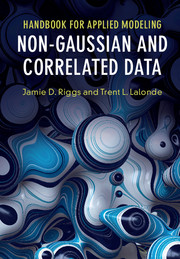Book contents
- Frontmatter
- Dedication
- Contents
- Preface
- 1 The Data Sets
- 2 The Model-Building Process
- 3 Constant Variance Response Models
- 4 Nonconstant Variance Response Models
- 5 Discrete, Categorical Response Models
- 6 Count Response Models
- 7 Time-to-Event Response Models
- 8 Longitudinal Response Models
- 9 Structural Equation Modeling
- 10 Matching Data to Models
- Bibliography
- Index
8 - Longitudinal Response Models
Published online by Cambridge University Press: 03 August 2017
- Frontmatter
- Dedication
- Contents
- Preface
- 1 The Data Sets
- 2 The Model-Building Process
- 3 Constant Variance Response Models
- 4 Nonconstant Variance Response Models
- 5 Discrete, Categorical Response Models
- 6 Count Response Models
- 7 Time-to-Event Response Models
- 8 Longitudinal Response Models
- 9 Structural Equation Modeling
- 10 Matching Data to Models
- Bibliography
- Index
Summary
Longitudinal Data
Researchers often collect data over time with the intention of predicting changes, growth, or other effects and associations over time. While there are many techniques for collecting data over time, the most powerful is the collection of panel data. Panel longitudinal data refer to observations made repeatedly on the same individuals or units over time. For example, health researchers may record physiological measures of patients such as systolic blood pressure during monthly visits to each patient's primary care physician; market analysts may record the GDP of a number of countries during each financial quarter of each year over a three-decade span; educational psychologists may track individual students’ motivation at multiple times during a school year. Researchers have various motivations for recording panel longitudinal data. There may be an interest in predicting differences, changes, or growth in the outcome of interest across time. There may also be an interest in the effects of other predictors on the response of interest. Researchers may also be interested in changes in the outcome between subjects, in addition to changes within subjects over time.
When modeling longitudinal panel data, it is important to account for the “repeated” nature of the data. Specifically, when responses are recorded multiple times for the same individuals or observational units, those responses are generally associated. This correlation among the outcomes, or autocorrelation, is a violation of the assumption of independence applied to normal regression models. Therefore it is important to construct models that allow for nonindependence of responses.
For example, when recording GDP for a number of countries during each quarter over the span of many years, it is reasonable to assume that successive measures of GDP for the same country will be positively correlated. If these correlated observations are treated as independent, it would appear that a number of different observations are showing similar behavior, thus supporting a certain relationship. However, in truth it is the same country's repeated responses showing this relationship, which is misleading and can result in incorrect reporting of significant associations. Correlated or longitudinal modeling and testing techniques are necessary to account for this potential inflation of significance.
- Type
- Chapter
- Information
- Handbook for Applied Modeling: Non-Gaussian and Correlated Data , pp. 152 - 182Publisher: Cambridge University PressPrint publication year: 2017



